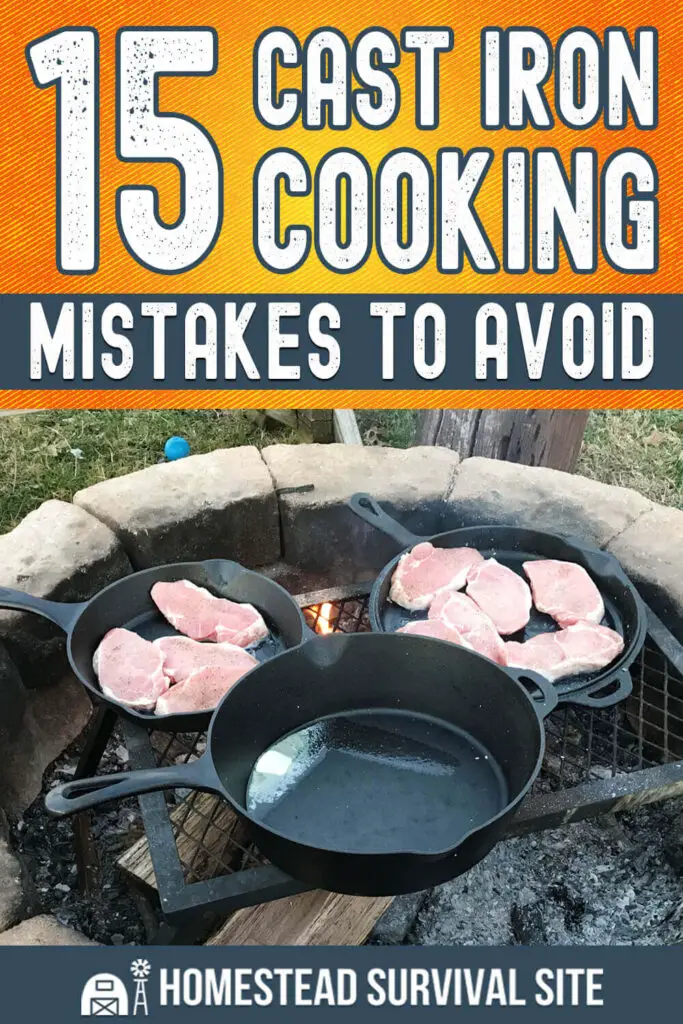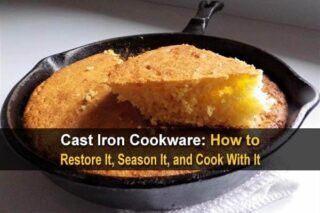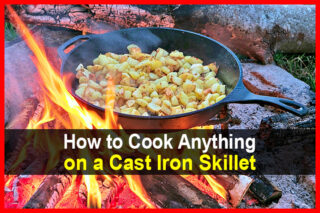Estimated reading time: 6 minutes
Cast iron cooking secrets are often passed down through generations. Many cooks learn from those before them how to make entire meals with one simple cast iron pan. For the fortunate few, the actual cast iron pots and pans are inherited along with the coveted knowledge.
Look for this forgiving, unsung hero on primitive campfires to the most upscale, modern kitchens. This cookware workhorse allows you to bake, fry, sear, and saute almost anything. With proper care, it can last your lifetime and that of your children.
Cooks new to historic cast iron don’t realize it is the original non-stick cookware. A well-seasoned, non-greasy pan will cook up eggs and pancakes that will slide right from the pan to your dish!
Learning the rules of cast iron cookware is not difficult. Even if you don’t have granny and her heirloom pan, you too can become a pro. Learn the how-tos along with these 15 cast iron cooking mistakes to avoid.
Want to save this post for later? Click Here to Pin It On Pinterest!
Seasoning
Unfamiliarity With Seasoning
Seasoning cast iron pans has nothing to do with spices and taste. In this context, seasoning refers to the pan’s coating that builds up over time. This coating consists of many baked-in layers of polymerized oil. The benefits of seasoning include:
- Non-stick ability
- Easy clean-up
- Better rust resistance
Not Seasoning Regularly
Cast iron isn’t a “leave it and forget it” cookware. Every time you use your pan, you are wearing down some of that seasoning. You may not have to re-season it every time, but it doesn’t hurt – especially if you see dull spots on the pan’s finish. Even newer, pre-seasoned cast iron pans benefit from initial seasonings. However, regular treatments will keep that shiny, non-stick black finish.
How To Season Your Cast Iron Pan
It really is pretty easy to season your pan. But, the more you do it, the better it’ll be.
- Preheat the oven to 350 degrees and place a baking sheet on the bottom rack.
- Coat the entire pan with a thin layer of vegetable oil – inside, outside, and handle.
- Place the pan in the oven upside down and heat for an hour.
- Turn off the oven and allow your pan to cool down completely.
- When cool, wipe the pan with a paper towel and store it correctly.
Cleaning
Not Cleaning Promptly
Cast iron cookware is easiest to clean when still a bit warm. Allowing food to dry in the pan makes it harder to clean, especially if the pan hasn’t yet built up a good seasoning coat.
Letting Your Pan Soak In Water
Some cookware enjoys a good soaking when crusted with food. Cast iron does NOT, as soaking in water promotes rust. A quick rinse in warm water usually removes most of the heavier debris. NEVER put your cast iron pieces in a dishwasher – EVER.
Using Strong Soap
Mild dish soap can be used sparingly with cast iron, contrary to some schools of thought. The key is to rinse well, dry thoroughly, and reseason regularly. Never use harsh chemicals like oven cleaner, even if your pan is rusty.
A good salt or baking soda scrubbing can clean as well as most soaps. While the pan is still warm, rinse with water and sprinkle a generous amount of coarse salt in it. Next, scrub the pan with a dishcloth and rinse. Dry completely.
Giving Up On a Rusty Pan
Rust isn’t an instant death sentence for cast iron. If it’s a small spot, a quick scrub can sometimes suffice. Heavily rusted pans need a good stripping and reseasoning. It is rare that a rusted cast iron pan isn’t salvageable.
Cooking
Not Heating The Plan, Or Overheating It
One of the few issues with cast iron cookware is that it doesn’t always cook evenly. Allow the pan to heat up completely and slowly before adding any food. Don’t forget that the handle heats up too, so use a thick pad or handle cover.
On the other hand, overheating can occur. Begin warming your pan at a lower temperature until heated through. If it starts smoking, you’ll know you need to turn down the heat and allow the pan to cool a bit before proceeding.
Using The Pan For Acidic Foods
This is another area where cast iron chefs often disagree. Some insist that you should never cook acidic foods in your beloved pans. Others say go ahead and just plan on a good cleaning and reseasoning. Some acidity may discolor cast iron, but using a baking soda and salt scrub can help.
Not Cooking Enough
Cast iron cookware is something that improves with age and use. So even though some of the seasoning does wear away every time you cook, you will also be adding to the layers as you go. As a result, your pans will become darker, slicker, and shinier with each meal prepared.
Storage
Improper Storage
Be sure your cast iron pots and pans are completely dry before storing them. If you are stacking them, place a paper towel, dishcloth, or felt separator between them.
Storing Leftovers In Your Cast Iron
One of the worst things you can do is to store leftovers in your cast iron. The moisture in the food, along with that of the refrigerator, can encourage rust and pitting.
A Few More Tips
Using a metal spatula won’t hurt your cast iron pan. In fact, a good, sturdy spatula will make cooking in cast iron a lot easier.
Iron molecules leaching into your food from cast iron cookware is not a bad thing. Many doctors tell anemic patients to cook in cast iron for this benefit.
Sturdy nylon scrub brushes are usually enough to clean most debris from your cast iron. Steel wool isn’t recommended, but small chainmail scrubbers are quite effective.
Cast iron pans can take on the flavors and fragrance of some of the foods prepared in them. This is especially true of fish and seafood, which will often bless your next dish with a fish flavor. As a result, some cooks choose to have a second pan dedicated to these types of dishes.
Final Thoughts
Now you know some of the worst cast iron cooking mistakes to avoid, along with some of the best things you can do to make it last a lifetime. So get to cooking in your seasoned and well-cared-for cast iron cookware!
Like this post? Don't Forget to Pin It On Pinterest!













I’ll never forget the time I caught my Mother in Law, trying to season her pan on the stove top. A big NoNo, and not an it’s better than nothing option.
You end up with a pan totally useless for cooking..
Sorry, I have re-seasoned cast iron as well as carbon steel on a gas stove top many times with great success. Just on a steady low and slow just not too hot.
My Great grandmother never mixed her cast Iron pans. She had one for pork, another for beef, another for potatoes, etc. she would say that by using certain pans for certain foods, the food taste wouldn’t be transferred to food being cook. What is your thought on this?